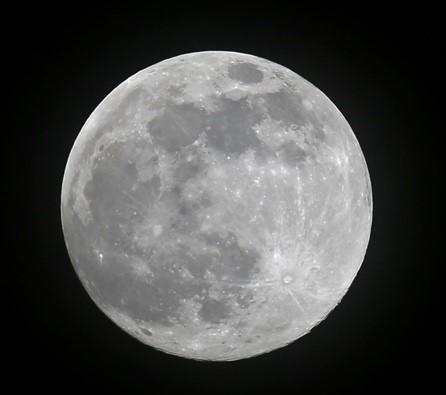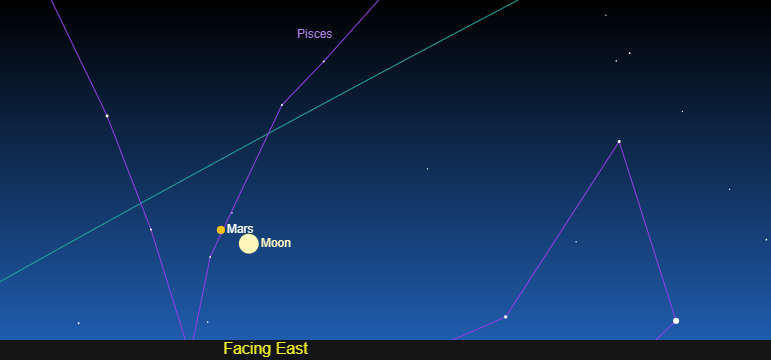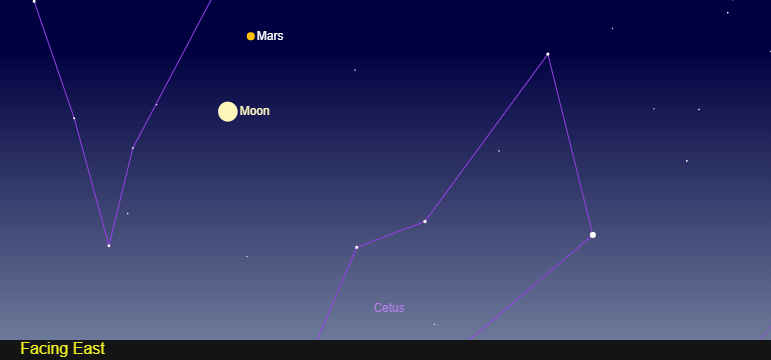
October 2020 will be dominated by an impressive appearance of Mars, the red planet. It will also feature not one, but TWO full moons, the latter occurring on Halloween. The second full moon by some standards is called a “blue moon.” Of this, more later.
As mentioned in last month’s blog entry, Earth is currently passing Mars, an event which happens every 26-27 months. However, this pass is exceptional because Mars is also near its closest point to the Sun in its eccentric orbit and is situated high in the sky for northern latitudes. Closest approach to Earth, 38.6 million miles, will occur on October 6, while opposition (Mars most nearly opposite to the Sun in the sky) will be on the 13th. All month long, Mars can be seen rising in the east in the early evening, very high up in the south in the middle of the night, and then setting in the west towards dawn. Mars is immediately obvious to identify due to its reddish-orange color.
Compare Mars to Jupiter and Saturn, which form a close pair fairly low in the south in the early evening, and then lower in the southwest in the late evening. To my eyes, Jupiter shines with an almost pure white color, while Saturn, much dimmer, is dull yellow, hinting at its great distance of nearly a billion miles from Earth. Which is brighter, Mars or Jupiter? Astronomical almanacs suggest that this is one of the rare times when Mars should just slightly exceed its giant sibling. Take a look yourself- the answer might depend upon how high they appear above the horizon as well the color preferences of your own eyes and brain. To catch a fourth easy bright planet, get up an hour or two before sunrise- not that hard with dawn coming late at this time of year. By then Mars is getting low or may have set in the west, but Venus, much brighter, dominates the east. Mercury, the fifth possible naked eye planet, is out of easy sight this month but will have a good morning appearance in November.
The Moon will be exactly Full at 4:06 pm on October 1st. Traditionally, this Full moon closest to the fall equinox is called the “Harvest Moon.” The line of the ecliptic, the path of the Sun, Moon, and planets in the sky, forms a very shallow angle to the eastern horizon at dusk at this time of year. This causes the moon to rise above the horizon less than a half hour later each night when near the Harvest Moon. This added light from the brilliant Full Moon can help farmers to bring in their crops. The Full Moon following the Harvest Moon is called the “Hunter’s Moon”, and the effect is similar. This year, on October 2nd (upper image) with the Moon still almost indistinguishable from full, Mars and the Moon will rise closely together around 7:30 PM, an unforgettable sight. There will be another passage on the 29th, not quite as close (lower image). Both images are courtesy Sky & Telescope magazine.


Since the Moon takes about 29.5 days to complete a cycle of phases, there sometimes is a second full moon within the same calendar month. In recent years, the second full moon in a month has come to be called a “blue moon.” This description seems to have been popularized by a mistaken article in 1943, but it has stuck. Traditionally, however, the term “blue moon” referred to the third full moon in a season that has four. For a season to qualify, a full moon has to occur very close to the date of the equinox or solstice. By this standard, this autumn does not have a blue moon. The moon almost never actually looks blue, but this has been reported at times when there is extreme dust in the atmosphere, usually from volcanic eruptions. I sometimes have seen just a hint of blue during lunar eclipses, at the border between the umbral shadow and the brightly lit portion.
Once every nineteen years, a Full Moon can occur on Halloween. With 2020 being what it is- this is the year, officially at 9:51 am St. Louis time! I had thought of setting up my telescope outside my house as an additional “treat” for the neighborhood trick-or-treaters, but these plans, like so many others these days, will have to be modified by the pandemic. Wouldn’t you know it?
Don't miss the our October 24 Gateway to the Stars program! At 7 pm, our Sky Ranger will present a short talk about current sky events. This will be followed by a narrated tour of the night sky by St. Louis Astronomical Society member John Strebeck using the Stellarium computer program, as well as video of the Moon and planets submitted by SLAS members. This program will be FREE and streamed live at www.facebook.com/stlastro.
